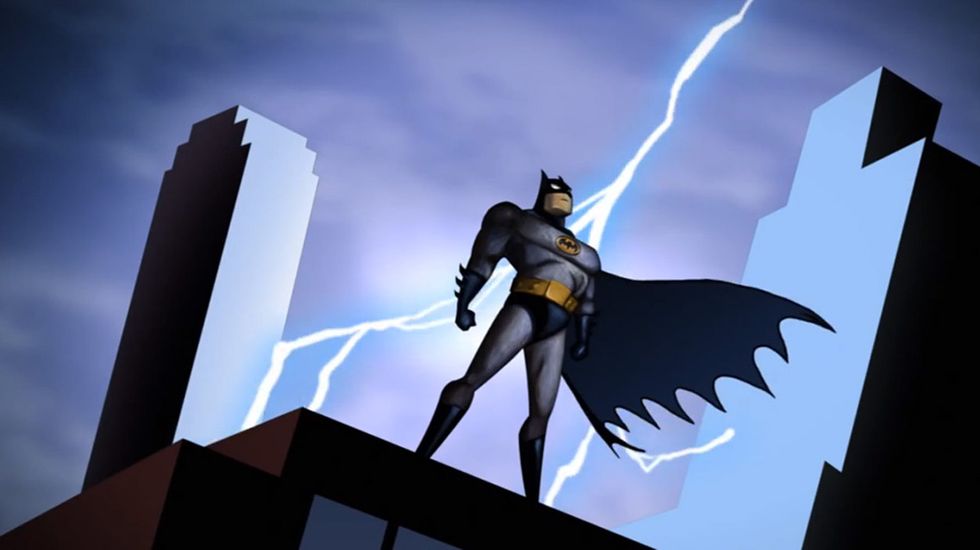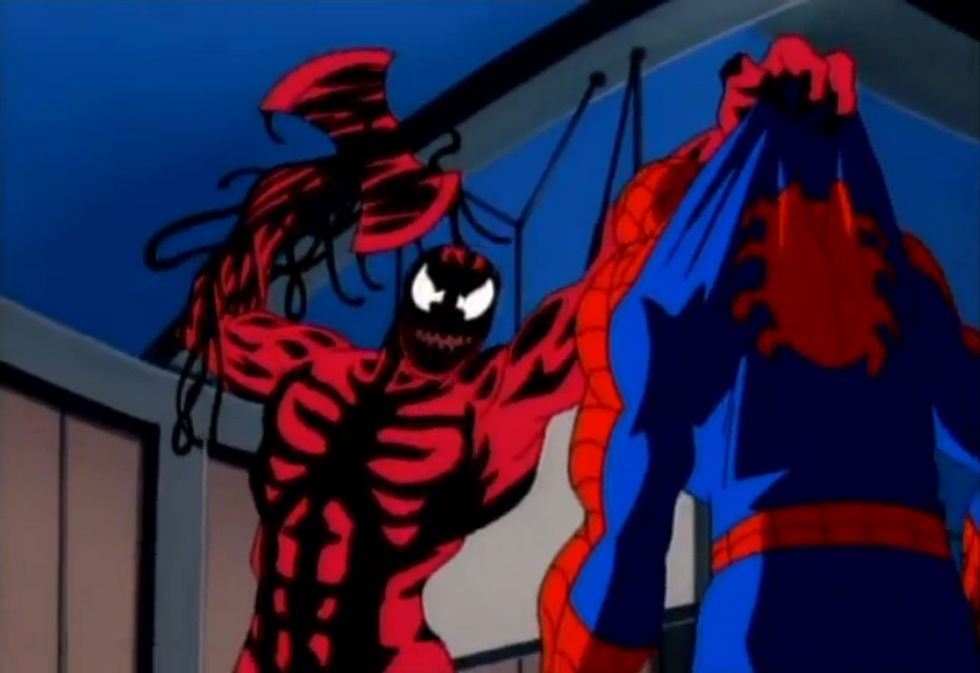I've written a lot of articles on the Marvel Cinematic Universe, and how it was unexpected and how they took their time developing these movies into the cultural phenomenon they are today. And trust me, I'll write even more as time goes on. However, these movies are not the first time there was a shared universe of comic book media. Of course there's always been actors reprising roles across different projects, but in the 1990s and early 2000s, both Marvel and DC had their own universes in animation. The DC Animated Universe (DCAU) and the untitled but still great Marvel animated universe defined superhero cartoons, certain aspects of both still being a major part of the comic book fandom. With that in mind, let's take a look at the cartoons that revitalized the animation market.
Following the success of the 1989 Tim
Burton Batman film and to
help keep the character in the mindset of children after Batman
Returns, Warner Brothers
partnered with Fox Kids to produce a television series based on the
Batman mythos. Bruce Timm and Paul Dini came onboard as writers and
designers, coming up with a unique style and tone – the show would
be aired in a timeslot for kids, but would be darker and even more
adult-targeted than most other cartoons at the time. Actor Kevin
Conroy was signed on as Batman, and after a recasting following a
mutual agreement with Tim Curry, Mark Hamill was cast as the Joker.
The show was an instant hit, with critics praising the voice talent,
the writing, the animation, and the gritty tone to the series
overall. It was followed up by Superman: The Animated
Series in 1996, and Conroy
reprised his role in several episodes. Characters crossed over back
and forth, and on Superman,
heroes such as the Flash and Green Lantern were introduced to the
small but growing universe. In 1999, after Batman: The
Animated Series was canceled,
Dini and Timm moved on to creating their own original DC series, this
one being about a new person taking up the Batman mantle in the far
future, titled Batman Beyond.
Another huge hit, the show once again saw Conroy's Batman, now an
elderly, retired Bruce Wayne. Just as this show was ending in 2001,
the DCAU was still popular, and considering they had several
characters already established in some way, Justice League
was produced, and became one of the most famous and praised comic
book cartoons of all time. The show was always adding new heroes to
the mix, from icons like Wonder Woman and Green Arrow to more obscure
ones like Red Tornado and Hawkgirl. Yet another show that tied into
Justice League was put
on air – Static Shock, based
on the 1990s comic series. This show even had episodes on racism and
gun violence, making it stand out against the rest of the DCAU. By
2006, however, the shows had ran their course, and Justice
League, now titled Justice
League Unlimited, was canceled,
ending the fourteen year production on the universe.
In the 1990s, Marvel was going bankrupt. To get some extra cash, they sold off film rights to most of their characters, and started working on television programs to try and drive up merchandising money. Also working with Fox Kids, a series based on the X-Men was put to air in 1992, and much like BTAS, the series was darker than most other shows, but still kept a comic book feel to it. With this hit on their hands, Marvel looked to other characters they had to work with, and ordered another couple of shows to be made – Iron Man, Fantastic Four, and The Incredible Hulk. Unlike X-Men, however, none of these cartoons were huge successes, but still got a couple of seasons. Here, characters began crossing over – such as Hulk being on an episode of Fantastic Four, with their respective voice actors carrying over into the other show. In 1994, Marvel premiered the famous Spider-Man: The Animated Series. The show is also infamous for restrictions Fox Kids and Canon Films put on the writers – no realistic guns, no punches, words like “kill” and “death” were banned, no origin story, and villains Sandman and Electro were off-limits. Despite these, the series was rivaling Batman as a superhero cartoon. While Spider-Man himself never appeared on other shows, characters would cross into this regularly. As Spider-Man was wrapping up a few years later, the idea of doing a loose sequel series came to mind, and a new cartoon was commissioned. Spider-Man: Unlimited was a very strange take on the character – he was sent to a parallel universe and had to fight to get his way back home. It didn't work out all that much, nor did Silver Surfer, a cartoon that had little connection to the Fantastic Four series on which the Surfer appeared. In 2000, after the less-than-stellar Avengers: United They Stand series that was Avengers-in-name-only, the Marvel television universe was ended, and production moved to different shows, including X-Men Evolution. Unlike DC, Marvel's universe was very loosely connected, existing mostly because actors were playing the same characters in single episodes of shows, whereas DC was crossing over villains and heroes pretty regularly. It should be noted that Mark Hamill also portrayed the Hobgoblin on Spider-Man: The Animated Series, being one of the few actors to play both a major Marvel and a major DC character at the same time.
So
what effect did these franchises have? For one, the DCAU introduced
Harley Quinn, who has since become one of DC's most popular
characters. It also started the continuing run of Conroy and Hamill
in their respective roles. The influence of the DCAU in the comics
cannot be overstated – the origin story for Mr. Freeze was changed
in the comics to reflect the origin from Batman: The
Animated Series. Batman
Beyond has a cult following and
a currently-publishing comic series. On the other hand, the Marvel
animated universe popularized the X-Men in the early 1990s, after the
comics had lost some of their appeal in the late 80s. In turn, this
caused Fox to look into making an X-Men film, creating the movie saga
that is still being released now (though we'll have to see what
happens when the Disney sale goes through.) Venom, a relatively new
villain, was given mass exposure outside of comic fandom because of
the Spider-Man cartoon.
Justice League Unlimited
had a similar effect, introducing the mainstream audience to more
unknown and obscure heroes and villains. Marvel's own Spider-Man
Unlimited has a similar
following as Batman Beyond,
but not to the same extent – mostly the costume just shows up in
video games. The DCAU is much more influential, but the Marvel
universe was what kept the company going during their financial
troubles.
I
like both companies' shows – they defined my childhood superhero
fandom. Now, of course I prefer Batman: The Animated Series
over The Incredible
Hulk, but that doesn't mean one
is worse than the other. As of right now, DC doesn't really have
their own cartoon saga, though the Arrowverse does have some animated
components, whereas Marvel has a fully-developed and established
universe on Disney XD. The influence of the 1990s/2000s era will
continue to be seen in comics and related media, and rumors are going
around about a possible revival of the DCAU. Until then, well, it's
not like we don't have access to the originals. X-Men
defined the team for almost a decade, and the DCAU defined their
respective characters for that time as well. There's new cartoons,
new interpretations, but none as iconic as these were.










































